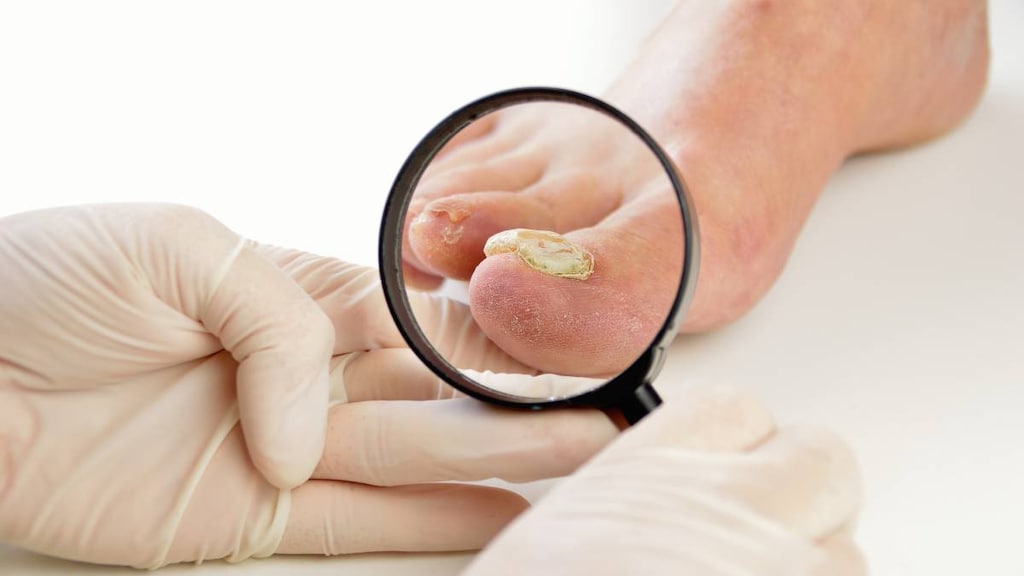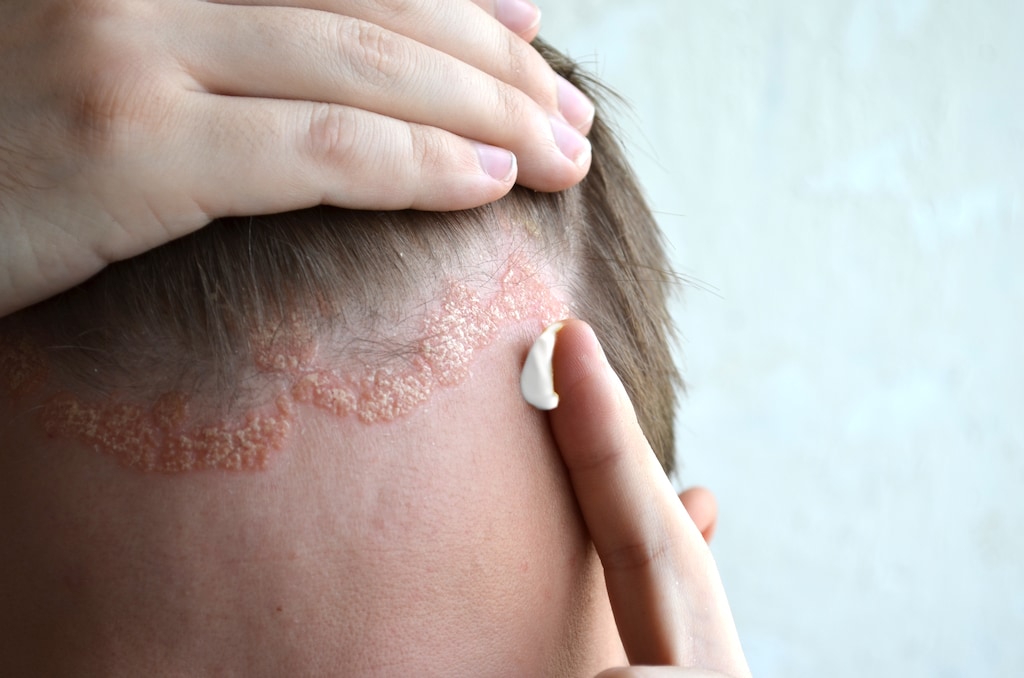Dosage Forms
Excipient information presented when available (limited, particularly for generics); consult specific product labeling. [DSC] = Discontinued product
Cream, External:
Dovonex: 0.005% (60 g, 120 g) [contains cetearyl alcohol, disodium edta]
Generic: 0.005% (60 g, 120 g)
Foam, External:
Sorilux: 0.005% (60 g, 120 g) [contains cetyl alcohol, edetate disodium, propylene glycol]
Generic: 0.005% (60 g)
Ointment, External:
Calcitrene: 0.005% (60 g, 120 g [DSC]) [contains disodium edta, propylene glycol]
Generic: 0.005% (60 g, 120 g)
Solution, External:
Generic: 0.005% (60 mL)
Pharmacology
Mechanism of Action
Synthetic vitamin D3 analog which regulates skin cell production and proliferation. Binds to vitamin D receptors and inhibits keratinocyte proliferation and enhances keratinocyte differentiation (Menter 2009).
Pharmacokinetics/Pharmacodynamics
Absorption
When applied to psoriasis plaques: Cream, foam: Undetermined; Ointment: ~6%; Solution: <1%
Metabolism
Absorbed calcipotriene is converted to inactive metabolites
Onset of Action
Improvement begins after 2 weeks; marked improvement seen after 8 weeks
Use: Labeled Indications
Plaque psoriasis: Treatment of plaque psoriasis of the body (cream, ointment) or of the scalp (solution) in adults; treatment of plaque psoriasis of the body or of the scalp in children ≥12 years of age, adolescents, and adults (foam)
Contraindications
Hypersensitivity to calcipotriene or any component of the formulation; patients with demonstrated hypercalcemia or evidence of vitamin D toxicity; use on the face (cream, ointment); patients with acute psoriatic eruptions (scalp solution)
Documentation of allergenic cross-reactivity for Vitamin D derivatives is limited. However, because of similarities in chemical structure and/or pharmacologic actions, the possibility of cross-sensitivity cannot be ruled out with certainty.
Dosage and Administration
Dosing: Adult
Plaque psoriasis: Topical:
Cream: Apply a thin film to the affected skin twice daily
Foam: Apply a thin film to the affected skin or scalp twice daily
Ointment: Apply a thin film to the affected skin once or twice daily
Solution: Apply to the affected scalp twice daily
Dosing: Geriatric
Refer to adult dosing.
Dosing: Pediatric
Plaque psoriasis; mild to moderate: Topical: Note: Vitamin D analogs (eg, calcipotriene) are considered first-line treatment options in pediatric patients (particularly to minimize corticosteroid exposure) with or without topical corticosteroids (AAD [Menter 2009]; de Jager 2010; Zeichner 2010).
Foam: Sorilux: Children ≥12 years and Adolescents: Apply a thin layer to affected areas of scalp and body twice daily; in one clinical trial, subjects had mild to moderate psoriasis covering 2% to 20% of BSA; trial duration was 8 weeks (Feldman 2012).
Cream, ointment: Limited data available: Children ≥2 years and Adolescents: Apply a thin layer to affected areas of scalp and body twice daily; ointment dosing based on multi-center trials including over 100 children ≥2 years of age and adolescents with mild to moderate psoriasis covering <30% BSA; overall improvement (based on psoriasis scores) was reported in over 60% of patients in an open-labeled trial; similar efficacy results (>50% improvement) was reported in a placebo-controlled study; however, this was not statistically significant (Darley 1996; Oranje 1997); cream dosing based on a small trial, experience with ointment formulation, and expert recommendations (AAD [Menter 2009]; Duweb 2003; Schachner 2010; Zeichner 2010)
Administration
For external use only. Avoid contact with face and eyes (rinse thoroughly with water if contact occurs).
Cream, foam, ointment: Apply to affected skin; rub in gently and completely. Wash hands thoroughly after use.
Foam, solution (scalp psoriasis): Prior to using, comb hair to remove debris; apply only to scalp lesions. Rub in gently and completely. Wash hands thoroughly after use. Foam should be applied when hair is dry.
If the use of multiple topical agents is necessary, apply the various agents at separate times throughout the day (Menter 2009).
Storage
Cream, ointment: Store at 15°C to 25°C (59°F to 77°F); do not freeze.
Foam: Store at 20°C to 25°C (68°F to 77°F); excursions permitted between 15°C and 30°C (59°F and 86°F); do not refrigerate or freeze. Contents are flammable; keep away from heat and flame. Do not puncture or incinerate. Do not expose to temperatures >49°C (120°F).
Solution: Store at 15°C to 25°C (59°F to 77°F); excursions permitted between 15°C and 30°C (59°F and 86°F); do not freeze. Solution should be kept away from open flame; avoid sunlight.
Drug Interactions
Aluminum Hydroxide: Vitamin D Analogs may increase the serum concentration of Aluminum Hydroxide. Specifically, the absorption of aluminum may be increased, leading to increased serum aluminum concentrations. Avoid combination
Calcium Salts: May enhance the adverse/toxic effect of Vitamin D Analogs. Monitor therapy
Cardiac Glycosides: Vitamin D Analogs may enhance the arrhythmogenic effect of Cardiac Glycosides. Monitor therapy
Hydrocortisone (Topical): May diminish the therapeutic effect of Calcipotriene. Management: Monitor for reduced calcipotriene efficacy if combined with hydrocortisone valerate. Consider separating the administration of these agents by 10 to 12 hours to minimize the risk of this potential interaction. Monitor therapy
Lactic Acid: May diminish the therapeutic effect of Calcipotriene. Management: Monitor for reduced calcipotriene efficacy if combined with lactic acid. Consider separating the administration of these agents by 10 to 12 hours to minimize the risk of this potential interaction. Monitor therapy
Multivitamins/Fluoride (with ADE): May enhance the adverse/toxic effect of Vitamin D Analogs. Avoid combination
Multivitamins/Minerals (with ADEK, Folate, Iron): May enhance the adverse/toxic effect of Vitamin D Analogs. Avoid combination
Salicylic Acid: May diminish the therapeutic effect of Calcipotriene. Management: Monitor for reduced calcipotriene efficacy if combined with salicylic acid. Consider separating the administration of these agents by 10 to 12 hours to minimize the risk of this potential interaction. Monitor therapy
Sucralfate: Vitamin D Analogs may increase the serum concentration of Sucralfate. Specifically, the absorption of aluminum from sucralfate may be increased, leading to an increase in the serum aluminum concentration. Avoid combination
Thiazide and Thiazide-Like Diuretics: May enhance the hypercalcemic effect of Vitamin D Analogs. Monitor therapy
Vitamin D Analogs: May enhance the adverse/toxic effect of other Vitamin D Analogs. Avoid combination
Adverse Reactions
Frequency may vary with site of application. Frequency not always defined.
Central nervous system: Tingling of skin (≤23%)
Dermatologic: Burning sensation of skin (≤23%), stinging of the skin (≤23%), skin rash (1% to 11%), dermatitis, desquamation, erythema, exacerbation of psoriasis, pruritus, skin irritation, xeroderma
Local: Application site pain (3%), application site erythema (2%)
<1%, postmarketing, and/or case reports: Allergic contact dermatitis, contact dermatitis, hypercalcemia, hyperpigmentation, folliculitis, skin atrophy
Warnings/Precautions
Concerns related to adverse effects:
- Contact dermatitis: Contact dermatitis, including allergic contact dermatitis, may occur.
- Hypercalcemia: May cause transient increases in serum calcium (reversible); if hypercalcemia occurs, discontinue treatment until calcium levels return to normal.
- Irritation: Transient irritation of both lesions and surrounding uninvolved skin may occur; discontinue use if irritation occurs.
Special populations:
- Elderly: Use with caution in elderly patients; severity of skin-related adverse reactions may be increased compared to younger adults.
- Pediatric: Children may be at higher risk of systemic side effects due to a greater skin surface area:body weight ratio. In an off-label trial of pediatric patients (2 to 14 years of age) with psoriasis affecting <30% BSA, no serious adverse effects (including calcium or bone metabolism changed) were observed with calcipotriene ointment application for 8 weeks of therapy (Oranje 1997). With foam application in older pediatric patients (12 to <17 years of age), pharmacokinetic studies have not shown significant evidence of systemic calcipotriene absorption or any effects on indices of calcium metabolism.
Dosage form specific issues:
- Foam, solution: Flammable; keep the foam and the solution away from fire, flame, or smoking during and immediately following application.
- Propylene glycol: Some dosage forms may contain propylene glycol; large amounts are potentially toxic and have been associated hyperosmolality, lactic acidosis, seizures, and respiratory depression; use caution (AAP ["Inactive" 1997]; Zar 2007).
Other warnings/precautions:
- Appropriate use: For external use only; not for ophthalmic, oral, or intravaginal use. Avoid or limit excessive exposure to natural or artificial sunlight, or phototherapy. Thoroughly wash hands after use. The safety and effectiveness in dermatoses other than psoriasis have not been established. Do not use concurrently with products that may alter the pH of the vehicle (eg, topical lactic acid); if the use of multiple topical agents is necessary, apply the various agents at separate times throughout the day (Menter 2009).
Monitoring Parameters
Serum calcium
Pregnancy
Pregnancy Considerations
Information related to use in pregnancy has not been located. If treatment during pregnancy is needed, other agents may be preferred (Hsu 2012; Zeichner 2010). When other alternatives are not available, limit application area (Murase 2014).
Patient Education
What is this drug used for?
- It is used to treat plaque psoriasis.
Frequently reported side effects of this drug
- Dry skin
- Peeling
- Burning
- Stinging
- Skin irritation
- Skin tingling
Other side effects of this drug: Talk with your doctor right away if you have any of these signs of:
- High calcium like weakness, confusion, fatigue, headache, nausea and vomiting, constipation, or bone pain
- Signs of a significant reaction like wheezing; chest tightness; fever; itching; bad cough; blue skin color; seizures; or swelling of face, lips, tongue, or throat.
Note: This is not a comprehensive list of all side effects. Talk to your doctor if you have questions.
Consumer Information Use and Disclaimer: This information should not be used to decide whether or not to take this medicine or any other medicine. Only the healthcare provider has the knowledge and training to decide which medicines are right for a specific patient. This information does not endorse any medicine as safe, effective, or approved for treating any patient or health condition. This is only a brief summary of general information about this medicine. It does NOT include all information about the possible uses, directions, warnings, precautions, interactions, adverse effects, or risks that may apply to this medicine. This information is not specific medical advice and does not replace information you receive from the healthcare provider. You must talk with the healthcare provider for complete information about the risks and benefits of using this medicine.




